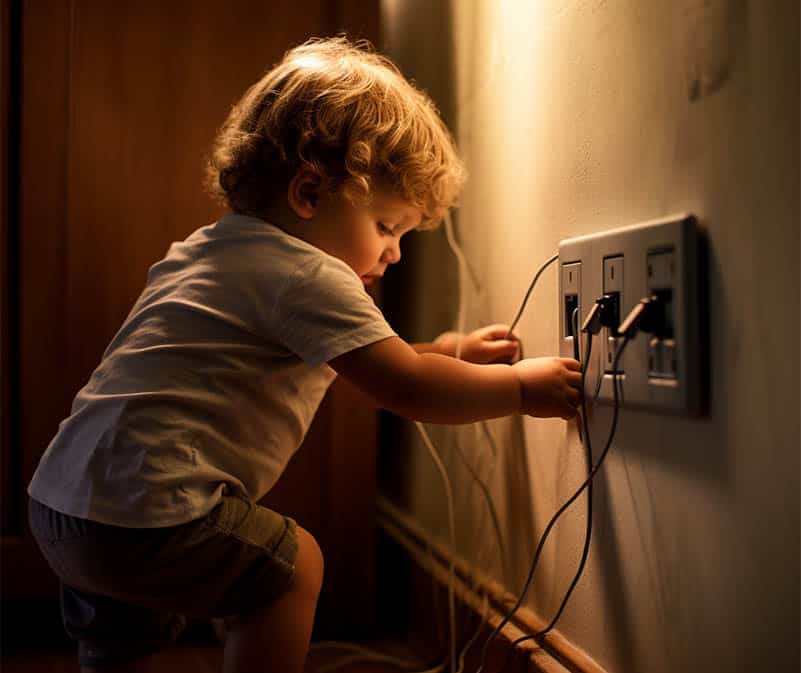Electrical Safety Inspections: 13 Ways to Protect Children

Electrical Safety Inspections Protect Children’s Lives When Revealing Serious Issues in Your Electrical Installation
As electricians in San Antonio, when we conduct an electrical safety inspection, we always check if there are children in the household. The very first role of our inspections is to protect families from the risks raised by sub-standard electrical installations.
The presence of children calls for special safety precautions because they are not aware of the dangers of electricity. Sometimes, the electrical installation itself is safe for adults and we don’t find any issue of any sort. But we will anyway share with the homeowners any potential danger we detect for their children.
Obviously, we can’t do electrical safety inspections in every single home of San Antonio. So this article gives families 13 solid pointers they can work with to minimize electrical risks.
Most of these 13 safety precautions are easy to take and low-cost. Please share them around you if you can.
1. Outlet Covers
Danger: Toddlers have a way to insert their fingers or objects into electrical outlets. This exposes them to electric shocks.
Solution: Use plastic outlet covers to block access.
Research indicates that the risk of children inserting objects into electrical outlets is more prevalent within the 2-4 age range.
- A study titled “Age Appropriateness and Safety of Electric Outlet Protectors for Children” found that 86% of the 182 reported injuries related to foreign objects in electrical receptacles involved children who were four years old or younger.
- Another case study by ANSI mentioned that toddlers between the ages of 2 and 3 accounted for half of the injuries related to electrical shock.
However, not all types of outlet protectors are really protecting our children.
- A study involving 37 children between the ages of 2 and 4 assessed the effectiveness of 3 different styles of outlet protectors. The researchers found that both 2-year-olds and 4-year-olds could remove certain types of protectors.
- The website AmericanFork.gov states that 47% of 4-year-olds and 18% of 2-year-olds could remove protectors with a 3/16-inch thick oval face and a tapered side. It also mentions that 100% of 2- and 4-year-olds could remove protectors with a 1/16-inch thick oval face and a flat side.
So there are good reasons for parents to make sure their outlets are covered with the right type of protectors.
2. Outlet Caps
Danger: Unused outlets attracting children.
Solution: Use outlet caps to cover unused outlets.
First, what’s the difference between outlet covers and outlet caps.
- Outlet covers are typically hard plastic cases that cover the entire outlet plate. Designed to replace the existing outlet plate, they have a spring-loaded sliding mechanism or a rotating cover that automatically closes the outlet when a plug is removed.
- Outlet caps (aka safety plugs or plug covers) are small individual plastic pieces that insert directly into the outlet’s plug slots. They are designed to be difficult for a child to remove.
We ought to mention that although outlet caps are very convenient, their capacity to protect children is limited. Field research by Temple University has shown that 100% of all 2-4 year-olds were able to remove one type of plastic outlet cap within 10 seconds!
The study suggests that tamper resistant receptacles are a more effective solution.
3. Tamper-Resistant Outlets (often recommended after an electrical safety inspection)

Danger: Danger comes from the observed fact that standard outlets are easily accessible to children.
Solution: Install tamper-resistant outlets that require a plug to open the safety shutters. Safety shutters won’t open unless a 2 bladed or grounded plug is inserted in the receptacle.
There again, some research backs up the use of tamper-resistant outlets.
- A study by the Electrical Safety Foundation International (ESFI) mentions that natural curiosity is the root cause for the risk of electrical shocks and burns threatening children. This study recommends using Tamper Resistant Receptacles (TRRs) to minimize this risk.
- According to a report by the National Fire Protection Association, a yearly average of 4,963 injuries were caused between 2008 and 2016 by electrical receptacles. The majority of these injuries occurred to children under the age of 18.
- An article found on the NFPA website states that injuries from outlets sent 5,500 people to the hospital in 2015. Some 27% of the injured were under the age of 5. The article suggests that tamper-resistant receptacles with built-in shutters are effective in preventing such injuries.
When we perform electrical safety inspection, we identify the areas where it would be better to install tamper-resistant outlets.
4. GFCI Outlets (often recommended after an electrical safety audit)
Danger: Water exposure near electrical outlets.
Solution: Install Ground Fault Circuit Interrupter (GFCI) outlets in bathrooms and kitchens. Actually, anywhere where water and electricity are in close proximity.
Obviously, children love to play with water and are unaware of the dangers of doing so near electrical outlets. As electricians, we often see in gardens and backyards. Someone installed electrical outlets neglectfully near spigots, and left them unprotected in areas with hoses and watering devices. A child can’t know that watering greenery near an electrical circuit without a GFCI outlet is a recipe for disaster.
Parents, please check your power outlets in your backyards and outside walls to make sure they are GFCIs and covered. If they aren’t, call us to change them. We wrote another article about GFCI outlets. Leave their installation to professional electricians: we will install and test them properly.
5. Cord Holders
Danger: Children can trip over loose cords, and chew on them.
Solution: Use cord holders to fasten cords against walls.
In this particular case, the use of electricity is not the root cause of accidents. Rather, this is the way electrical cords are hanging loose that exposes children to electric shocks.
The website HealthyChildren.org also mentions that very young children are most at risk because they bite into electrical cords. This risk extends to puppies: these guys will chew on anything left hanging.
6. Electrical Box Locks
Danger: Children accessing main electrical boxes.
Solution: Install locks on electrical boxes.
Any electrical box that a child can reach by climbing on a chair become a source of danger. Children are naturally curious and want to know “what’s in the box”. Parents, you have to be aware of this risk: no electrical box is safe from your children’s curious mind.
This is something we can flag during an electrical safety inspection.
7. Childproof Power Strips
Danger: Children can insert objects into power strip outlets.
Solution: Use power strips with built-in childproof features.
A “childproof power strip” has certain distinctive features:
- Outlet Covers: These are physical barriers that cover the electrical outlets on the power strip. Usually made of a durable plastic. You have to rotate or slide them to expose the outlet.
- Tamper-Resistant Outlets: These outlets have built-in safety shutters that block the insertion of foreign objects. The shutters will only open when applying equal pressure simultaneously to both slots (inserting a plug).
- Cord Management: Some childproof power strips come with a built-in cord management system to keep excess cord length out of reach of children. The system can be clips, Velcro straps, even a compartment to store any extra length of cord.
- On/Off Switch Lock: Some models come with a lockable on/off switch that prevents children from turning the power strip on or off.
- Grounded Outlets: For added safety, good power strips feature a ground prong to minimize the risk of electrical shock. Don’t buy a power strip without a ground prong.
- Angled Outlets: Some childproof power strips have angled outlets that make it more difficult for children to insert objects.
- Resettable Circuit Breaker: Not all power strips come with one. In case of an overload, the resettable breaker trips and cuts off power. This adds an extra layer of safety.
8. Recessed Outlets

Danger: Protruding outlets are more accessible to children.
Solution: Install recessed outlets to limit accessibility.
We can think of safety as “affordances” and “barriers”. Affordances allow access. Barriers restrict access. The most restrictions we place on direct access to electrical outlets, the safer our children.
Recessed outlets can require a bit more work to install than regular outlets, so if you decide to install some at the end of an electrical safety inspection, we will gladly give you a quote for this job.
9. Cord Shorteners
Danger: As mentioned earlier, children and pets will pull on long cords and possibly chew on them.
Solution: Use cord shorteners to keep excess length out of reach.
They come in different models. The website Dreambaby.com has one nifty cord shortener: it’s a round box with a rotating system. You insert the cord, rotate the mechanism to wound up the cord, and that keeps it tight.
There are other systems available on the market, such as little boxes that you mount on outlets. In these boxes, you can stuff the extra length of cord you don’t want your children to play with.
During electrical safety inspections, our electricians tend to pick up these small details and add them to their report to help parents make the best decisions for the safety of their children.
10. Safety Switches (often recommended after a safety audit)
Danger: Children turning on high-voltage appliances (as far as children are concerned, we look at high-voltage as anything above 12V).
Solution: Install safety switches that require a key or code.
The risks here are not as much electrical shocks as using dangerous electrical appliances. Children love to climb on chairs to reach things on countertops. Countertops are full of dangerous appliances, often connected to the mains and ready to operate at the pressing of a button.
So although this is not directly an electrical risk, we add it to our list of precautions because of the harm they can inflict. As electricians, we recommend using appliances with a safety switch that prevents a child from turning them on.
Here are some examples:
- Coffee grinder: Target stores carry a coffee grinder with a safety interlock on the On/Off switch. The grinder only operates when its lid is securely in place.
- Front control ranges: Certain ranges come with front controls for easy access and often include safety features like child locks and safety switches. You can find these ranges in any big box store.
- Smart wall oven: This type of wall oven comes with smart technology that allows you to control it via a smartphone. This adds an extra layer of safety as you can lock it remotely.
- Cooktops with safety lock: These cooktops often come with a safety lock feature that prevents the cooktop from accidental activation. This is especially important in induction cooktops: they do not have clearly indicator that zones are hot, unlike a traditional electric cooktop with its red lights, or a gas cooktop with its burners. The safety lock effectively prevents a child from turning dials and starting the heating process.
11. Arc-Fault Circuit Interrupters (often mandated after an electrical safety inspection)

Danger: Arcing can cause electrical fires.
Solution: Install AFCIs to detect and mitigate arcing conditions.
Arc Fault Circuit Interrupters (AFCIs) detect and mitigate the risks of electrical arcs, which can start electrical fires. While AFCIs are generally not child-specific safety devices, there are scenarios where children could inadvertently provoke incidents that AFCIs typically prevent.
Here are some examples:
- Damaging electrical cords: Children can damage electrical cords by biting, cutting, or fraying them, which could lead to arcing faults. AFCIs will detect these faults and cut off the electrical supply before a fire starts.
- Inserting objects into outlets: Out of curiosity, children often insert metal objects like paperclips, keys, or hairpins into electrical outlets. This can create an arc fault, which is a high-power discharge of electricity between different phases of the electrical system. AFCIs detect this and shut off the circuit.
- Overloading circuits: While this risk is less likely with younger children, teenagers can easily overload a circuit by plugging in too many devices into a single outlet, like video game consoles, laptops, and phone chargers. This can cause arcing and potentially lead to a fire. AFCIs can detect the arcing and disconnect the circuit.
- Tampering with electrical devices: Children can tamper with electrical devices, like taking them apart or modifying them. This can in turn create internal arcs. AFCIs detect this kind of fault and disconnect the circuit.
- Playing near electrical sources: Children often play near or behind electrical appliances like TVs or computers where they can partially dislodge a plug from its socket. A partially connected plug can lead to arcing. AFCIs detect this and shut off the circuit.
In these scenarios, AFCIs give an extra layer of protection. After conducting electrical safety inspections, we often recommend their installation.
12. Circuit Breakers Alarms
Danger: Undetected electrical issues.
Solution: Install circuit breaker alarms that alert for electrical hazards.
You don’t know what you don’t know. Many homeowners think their home is safe until an electrical inspection reveals all its weaknesses. As electricians in San Antonio, we often hear people saying their home passed the electrical inspection when they purchased it. Well done! But wait… When was it already? That was 10 years ago. Oh…
Many things happen to a house in the space of 10 years. Electrical wiring degrades. Terminations corrode. Wires get loose. Plastic electrical outlets become burned and brittle. Homeowners buy new appliances and increase the electrical load on their service panel, exceeding its capacity. New regulations find their way into the books. In our region of San Antonio, frequent thunderstorms and the typical power surges that accompany them can also weaken the safety of an installation.
When we conduct electrical safety inspections, we often recommend homeowners to install circuit breaker alarms. These will alert parents if a circuit breaker has tripped, due (for instance) to a child tampering with an electrical outlet or device.
13. Safety Labels

Danger: Children are unaware of electrical hazards.
Solution: Use safety labels to mark electrical installations and outlets.
This may surprise you, but it is possible to train young children to recognize danger symbols. Parents, label those areas of risk or dangerous spots in your home. Teach your children to identify the symbols. This is a very inexpensive way of making them aware of zones that are “out of bounds”.
Three researchers in Portugal conducted an experiment in 2015 on a group of 20 children (11 girls, 9 boys) aged 9-12. They tested the children’s ability to correctly name various types of dangers represented by warning symbols. Before the test, the children first receive a short period of training. The researchers rated as correct the answers describing the hazard. They rated as “partially correct” the answers identifying a danger but not specifying the action they had to avoid.
70% of the children completely understood the labels warning them of a danger of electric shock. Another 15% partially correctly understood the warning. The researchers also showed that regarding the design of the labels, 75% of the children associated the triangular shape as part of a “warning” symbol. Interestingly, black and red were the 2 colors spontaneously used by children to illustrate danger in their drawings.
Warning labels are not something we automatically think of when discussing methods of minimizing electrical risks. Yet, they can be an efficient tool to remind your children to not play around the wrong places.
The Role of Professional Electrical Safety Inspections
As we wrote earlier, you don’t know what you don’t know. That sounds like a truism, but the fact is most people never reevaluate the risks of electrical fire and electric shock inside their home after the initial purchase inspection.
These risks are of a very serious nature. They do materialize quite often in the form of loss of property, and loss of human and pet lives. We believe people’s attitude ought to change. Close the barn door before your horse bolts out.
Change can happen with informal, yet informative education. Hence this article. Please share it around.
Electrical safety inspections are another tool we offer for homeowners to become aware of any electrical risk and non-conformity that may exist in their home. And of course, to remedy it before it actually happens.
About us
All Star Electric has close to 30 years of experience as electrician in San Antonio. Over the years, we have conducted hundreds of electrical safety inspections in homes and businesses. Our team can repair any electrical installation and address any electrical risk successfully. We install smart home systems and help homeowners reduce their energy consumption. Being Tesla Certified Installers, we can install Level 1 and Level 2 EV chargers in your home and office. Our company operates in the areas of San Antonio, Castle Hills, Helotes, Selma and Alamo Heights, but we will come to any place where someone needs our help.




























